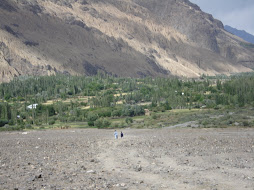Dawn
By Zar Alam Khan
ISLAMABAD, Aug 3: Elected representatives of Chitral have called upon the government not to yield to international pressure and go for the shortest and most viable Wakhan-Chitral route for the proposed import of electricity from Central Asia.
Talking to this correspondent, MNA Shahzada Mohiuddin, MPA Ghulam Mohammad and Mastuj Tehsil Nazim Shahzada Sikandar ul Mulk said Pakistan should not take risk on the vital national project by acceding to the proposal to opt for the Afghanistan route.
They pointed out that for the NWFP such an initiative also translated into opening up of a much-needed second trade corridor along the Khyber Pass, as the proposed route was not only geographically closer to Tajikistan and Kryghistan but was also very secure since it had remained peaceful throughout the three decades of war and strife in Afghanistan.
The World Bank estimates the project cost at around $600 million.
Given NWFP's close proximity to Tajikistan by a mere 35km, that is the distance separating Chitral from the Central Asian country, it becomes the natural choice for laying the high voltage transmission line via Boroghil Pass, the very junction separating the Amu Darya (Oxus River) from River Chitral (better known as Kabul River in NWFP).
They said on the Chitral side, a jeep track already exists up to Chikar (Petch Utz) at a distance of only 11km from Boroghil right across which a truck-able road exists on the Afghan side of Darwaza. The Tajik border town of Langar is a mere 13km away from Darwaza while the distance from Chitral's border to Khorog, the provincial capital of GABO (Gorno-Badakshan Autonomous Oblasc), is just 13 km – all having a truck-able road.
Moreover, Chitral is already linked with the national power grid and the transmission line via the valley would cover only 700km to reach Peshawar.
One of the proposed routes for the power import will run through Afghanistan’s Kunduz province, Salang Pass and Jalalabad before reaching Peshawar, stretching 170km in Tajikistan, 430km in Afghanistan and 50km in Pakistan.
In contrast, they said, the Wakhan-Chitral route would run 370km in Tajikistan, only 30km in the Wakhan corridor of Afghanistan and 310km in Pakistan.
They said policy makers would have to think twice about the Afghanistan route, as even Nato and Afghan forces have been unable to ensure their supply lines from Pakistan.
Another proposed route would run via the Ishkuman valley of the Northern Areas covering 70 per cent hard rock and pass through three major glaciers and three mountain ranges – Karakoram, Hindukush and Himalayas – before covering around 1,300 kilometers to reach Pakistan's nearest national grid.
The Northern Areas currently has no link with the national grid and work on the Basha-Diamer Dam will take at least 10-15 years. In contrast, if the transmission line were to follow the natural plateau of the Boroghil route into Chitral, it encounters no glaciers and follows the river bank with no mountain passes at all.
Interestingly, studies by the German organisation GTZ put Chitral's power generation capacity at 6,000-8,000 megawatts, making it a potential source of cash to propel the national economy.
Indigenous electricity generated from River Chitral, the NWFP's largest river, can be added to the same Central Asian transmission line, making it a dual purpose and cost-effective proposition, they added.
Without electricity, the province’s industrialisation through the creation of US-sponsored Reconstruction Opportunity Zones will also remain a pipe dream and so will be the desire to wean people away from militancy into gainful employment.
They said Americans who were encouraging the project to resolve the power crisis in Pakistan should also be keen to boost the economy of the NWFP by linking it to Central Asia. Upon completion, this route will also supplement the province’s income side-by-side the Khyber Pass as both the northern and southern portals of the Lowari tunnel meet around November this year
Monday, August 4, 2008
Subscribe to:
Post Comments (Atom)
Awesome and rugged

Beauty of Chitral

Kishmanja, a beautiful village in Yarkhun valley
Lush green

DIZG: threatened by floods

The legendary village of Ayun in Chitral

On way to Bumburet
Dizg, Yarkhun

Blog Archive
-
▼
2008
(197)
-
▼
August
(31)
- Culture's role in treatment of new mothers
- Infant mortality rate cut in Chitral
- Probe against revenue officer urged
- PML-Q MNA Mohiuddin joins PPP
- Few conversions in Kalash
- Truckers demand opening of Chitral-Dir road
- Chitral-Peshawar road closed at Lowari
- Compensation sought for festival's cancellation
- Community school set up in Yarkhun valley of Chitral
- Two heroes
- Wah blasts: body of Chitrali victim brought home
- 800 TB patients detected in Chitral every year
- Steps urged to reduce losses during disasters
- Position holders get cash awards
- Chitral's peace to be maintained
- Chitral forest a `windfall' for timber mafia
- Accord signed for Kalash valley uplift
- Lowari tunnel digging to complete by December
- Lowari tunnel digging to complete by December
- Plots distributed among heirs of policemen
- Plots distributed among heirs of policemen
- Chitral streets teem with garbage, where is TMA
- More girls colleges for Chitral demanded
- Chitral BHUs without doctors
- Wanted a bridge for Yarkhun valley
- TMA Chitral allocates funds for Tajikistan road
- Naib nazim resigns over minister's remarks
- Unesco urged to save ancient sites in Mastuj
- save ancient sites of Chitral
- Govt advised against Kabul route for power import
- Helicopter to the roof of the world
-
▼
August
(31)
About Me

- Zar Alam Khan Razakhel
- Village Dizg, Yarkhun valley, Chitral, Pakistan
- I blog at http://chitraltoday.net (ChitralToday) about Chitral, its people, culture, traditions and issues. I have been writing about Chitral since 2000. Chitral is a scenic valley in the extreme north-west of Pakistan.
No comments:
Post a Comment